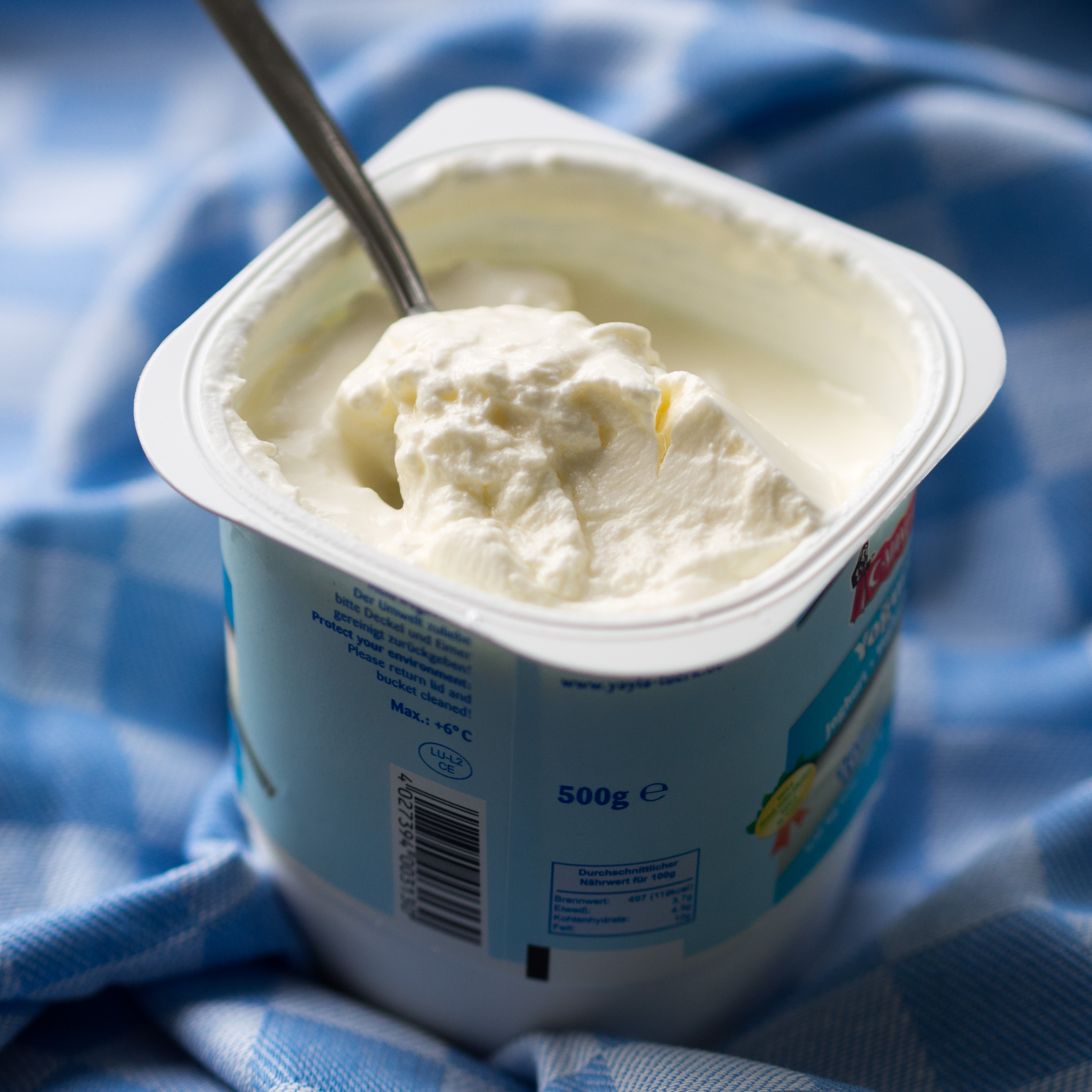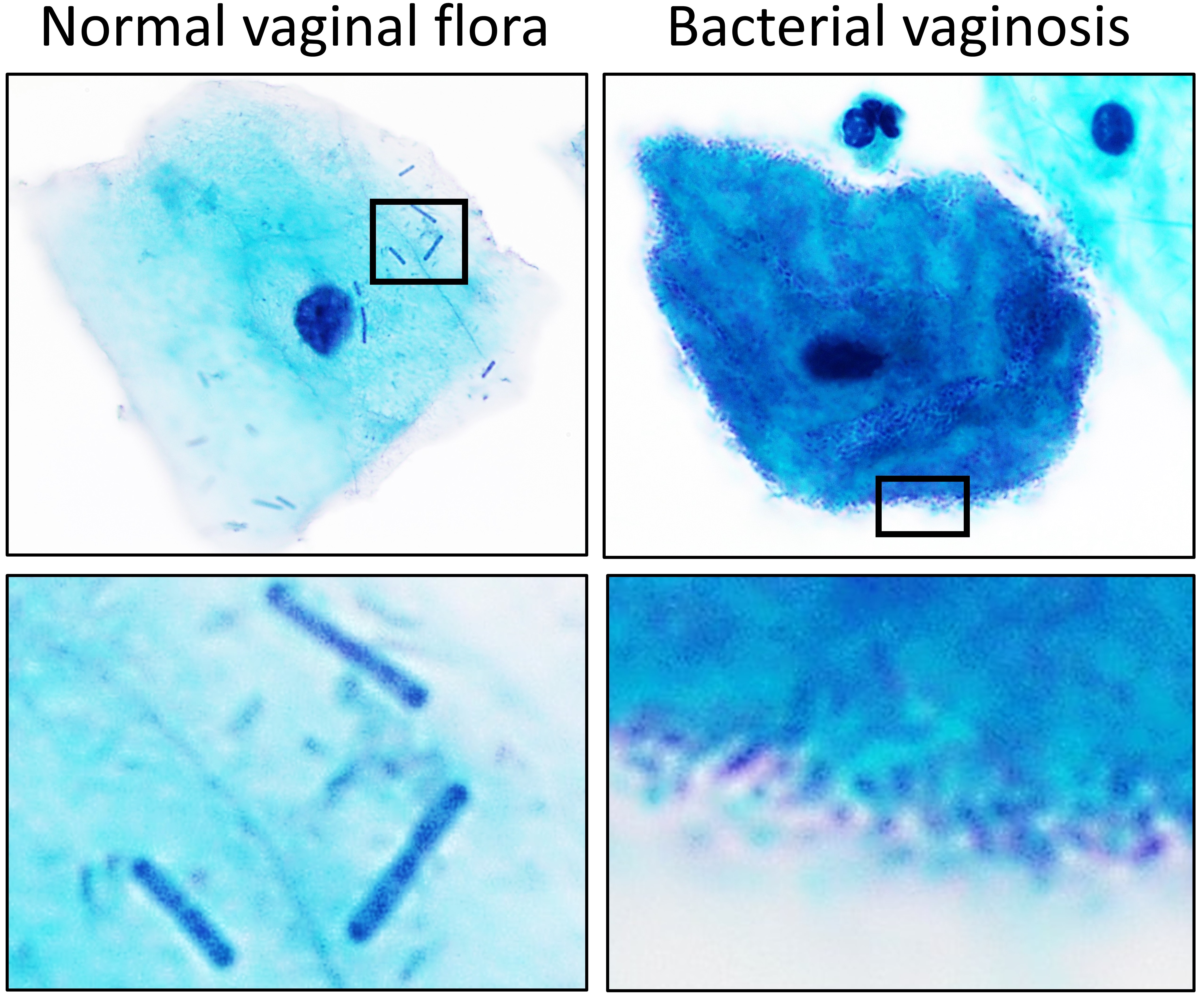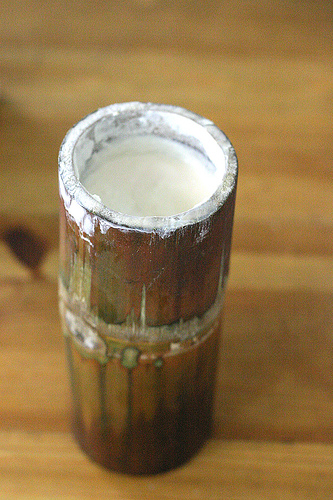|
Yogurts
Yogurt (; , from , ; also spelled yoghurt, yogourt or yoghourt) is a food produced by bacterial fermentation of milk. Fermentation of sugars in the milk by these bacteria produces lactic acid, which acts on milk protein to give yogurt its texture and characteristic tart flavor. Cow's milk is most commonly used to make yogurt. Milk from water buffalo, goats, ewes, mares, camels, and yaks is also used to produce yogurt. The milk used may be homogenized or not. It may be pasteurized or raw. Each type of milk produces substantially different results. Yogurt is produced using a culture of ''Lactobacillus delbrueckii'' subsp. ''bulgaricus'' and ''Streptococcus thermophilus'' bacteria. Other lactobacilli and bifidobacteria are sometimes added during or after culturing yogurt. Some countries require yogurt to contain a specific amount of colony-forming units (CFU) of bacteria; for example, in China the requirement for the number of lactobacillus bacteria is at least 1 million CFU ... [...More Info...] [...Related Items...] OR: [Wikipedia] [Google] [Baidu] |
Bifidobacterium
''Bifidobacterium'' is a genus of gram-positive, nonmotile, often branched anaerobic bacteria. They are ubiquitous inhabitants of the gastrointestinal tract though strains have been isolated from the vagina and mouth ('' B. dentium'') of mammals, including humans. Bifidobacteria are one of the major genera of bacteria that make up the gastrointestinal tract microbiota in mammals. Some bifidobacteria are used as probiotics. Before the 1960s, ''Bifidobacterium'' species were collectively referred to as ''Lactobacillus bifidus''. History In 1899, Henri Tissier, a French pediatrician at the Pasteur Institute in Paris, isolated a bacterium characterised by a Y-shaped morphology ("bifid") in the intestinal microbiota of breast-fed infants and named it "bifidus". In 1907, Élie Metchnikoff, deputy director at the Pasteur Institute, propounded the theory that lactic acid bacteria are beneficial to human health. Metchnikoff observed that the longevity of Bulgarians was the result ... [...More Info...] [...Related Items...] OR: [Wikipedia] [Google] [Baidu] |
Lactobacillus
''Lactobacillus'' is a genus of gram-positive, aerotolerant anaerobes or microaerophilic, rod-shaped, non-spore-forming bacteria. Until 2020, the genus ''Lactobacillus'' comprised over 260 phylogenetically, ecologically, and metabolically diverse species; a taxonomic revision of the genus assigned lactobacilli to 25 genera (see below). ''Lactobacillus'' species constitute a significant component of the human and animal microbiota at a number of body sites, such as the digestive system and the female genital system. In women of European ancestry, ''Lactobacillus'' species are normally a major part of the vaginal microbiota. ''Lactobacillus'' forms biofilms in the vaginal and gut microbiota, allowing them to persist in harsh environmental conditions and maintain ample populations. ''Lactobacillus'' exhibits a mutualistic relationship with the human body, as it protects the host against potential invasions by pathogens, and in turn, the host provides a source of nutrients ... [...More Info...] [...Related Items...] OR: [Wikipedia] [Google] [Baidu] |
Sheep
Sheep (: sheep) or domestic sheep (''Ovis aries'') are a domesticated, ruminant mammal typically kept as livestock. Although the term ''sheep'' can apply to other species in the genus '' Ovis'', in everyday usage it almost always refers to domesticated sheep. Like all ruminants, sheep are members of the order Artiodactyla, the even-toed ungulates. Numbering a little over one billion, domestic sheep are also the most numerous species of sheep. An adult female is referred to as a ''ewe'' ( ), an intact male as a ''ram'', occasionally a ''tup'', a castrated male as a ''wether'', and a young sheep as a ''lamb''. Sheep are most likely descended from the wild mouflon of Europe and Asia, with Iran being a geographic envelope of the domestication center. One of the earliest animals to be domesticated for agricultural purposes, sheep are raised for fleeces, meat ( lamb, hogget or mutton), and milk. A sheep's wool is the most widely used animal fiber, and is usually harvested by ... [...More Info...] [...Related Items...] OR: [Wikipedia] [Google] [Baidu] |
Streptococcus Thermophilus
''Streptococcus thermophilus'' formerly known as ''Streptococcus salivarius ''subsp.'' thermophilus'' is a gram-positive bacteria, gram-positive bacterium, and a lactic acid fermentation, fermentative facultative anaerobic organism, facultative anaerobe, of the ''Streptococcus viridans, viridans'' group. It tests negative for cytochrome, oxidase, and catalase, and positive for alpha-hemolytic activity. It is motility, non-motile and does not form endospores. ''S. thermophilus'' is fimbria (bacteriology), fimbriated. It is also classified as a lactic acid bacteria, lactic acid bacterium. ''S. thermophilus'' is found in fermented milk products and is generally used in the production of yogurt, alongside Lactobacillus delbrueckii subsp. bulgaricus, ''Lactobacillus delbrueckii'' subsp. ''bulgaricus''. The two species are synergistic, and ''S. thermophilus'' probably provides ''L. d. bulgaricus'' with folic acid and formic acid, which it uses for purine synthesis. ''S. thermophil ... [...More Info...] [...Related Items...] OR: [Wikipedia] [Google] [Baidu] |
Lactobacillus Delbrueckii Subsp
''Lactobacillus'' is a genus of gram-positive, aerotolerant anaerobes or microaerophilic, rod-shaped, non-spore-forming bacteria. Until 2020, the genus ''Lactobacillus'' comprised over 260 phylogenetically, ecologically, and metabolically diverse species; a taxonomic revision of the genus assigned lactobacilli to 25 genera (see below). ''Lactobacillus'' species constitute a significant component of the human and animal microbiota at a number of body sites, such as the digestive system and the female genital system. In women of European ancestry, ''Lactobacillus'' species are normally a major part of the vaginal microbiota. ''Lactobacillus'' forms biofilms in the vaginal and gut microbiota, allowing them to persist in harsh environmental conditions and maintain ample populations. ''Lactobacillus'' exhibits a mutualistic relationship with the human body, as it protects the host against potential invasions by pathogens, and in turn, the host provides a source of nutrients. L ... [...More Info...] [...Related Items...] OR: [Wikipedia] [Google] [Baidu] |
Fermented Dairy Product
Fermented milk products or fermented dairy products, also known as cultured dairy foods, cultured dairy products, or cultured milk products, are dairy foods that have been made by fermenting milk with lactic acid bacteria such as ''Lactobacillus'', '' Lactococcus'', and '' Leuconostoc''. The fermentation process increases the shelf life of the product while enhancing its taste and improving the digestibility of its milk. There is evidence that fermented milk products have been produced since around 10,000 BC. A range of different Lactobacilli strains has been grown in laboratories allowing for many cultured milk products with different flavors and characteristics. These bacteria allow the production of many fermented milks such as cheese, yogurt, kefir, butter Most of the bacteria needed to make these product thrive under specific conditions, meaning that the right environment is crucial to the making of the fermented products. Products Many different types of cultured ... [...More Info...] [...Related Items...] OR: [Wikipedia] [Google] [Baidu] |
Mesopotamia
Mesopotamia is a historical region of West Asia situated within the Tigris–Euphrates river system, in the northern part of the Fertile Crescent. Today, Mesopotamia is known as present-day Iraq and forms the eastern geographic boundary of the modern Middle East. Just beyond it lies southwestern Iran, where the region transitions into the Iranian plateau, Persian plateau, marking the shift from the Arab world to Iran. In the broader sense, the historical region of Mesopotamia also includes parts of present-day Iran (southwest), Turkey (southeast), Syria (northeast), and Kuwait. Mesopotamia is the site of the earliest developments of the Neolithic Revolution from around 10,000 BC. It has been identified as having "inspired some of the most important developments in human history, including the invention of the wheel, the planting of the first cereal crops, the development of cursive script, mathematics, astronomy, and agriculture". It is recognised as the cradle of some of t ... [...More Info...] [...Related Items...] OR: [Wikipedia] [Google] [Baidu] |
Neolithic
The Neolithic or New Stone Age (from Ancient Greek, Greek 'new' and 'stone') is an archaeological period, the final division of the Stone Age in Mesopotamia, Asia, Europe and Africa (c. 10,000 BCE to c. 2,000 BCE). It saw the Neolithic Revolution, a wide-ranging set of developments that appear to have arisen independently in several parts of the world. This "Neolithic package" included the History of agriculture, introduction of farming, domestication of animals, and change from a hunter-gatherer lifestyle to one of sedentism, settlement. The term 'Neolithic' was coined by John Lubbock, 1st Baron Avebury, Sir John Lubbock in 1865 as a refinement of the three-age system. The Neolithic began about 12,000 years ago, when farming appeared in the Epipalaeolithic Near East and Mesopotamia, and later in other parts of the world. It lasted in the Near East until the transitional period of the Chalcolithic (Copper Age) from about 6,500 years ago (4500 BCE), marked by the development ... [...More Info...] [...Related Items...] OR: [Wikipedia] [Google] [Baidu] |
Central Asia
Central Asia is a region of Asia consisting of Kazakhstan, Kyrgyzstan, Tajikistan, Turkmenistan, and Uzbekistan. The countries as a group are also colloquially referred to as the "-stans" as all have names ending with the Persian language, Persian suffix "-stan" (meaning ) in both respective native languages and most other languages. The region is bounded by the Caspian Sea to the southwest, European Russia to the northwest, China and Mongolia to the east, Afghanistan and Iran to the south, and Siberia to the north. Together, the five Central Asian countries have a total population of around million. In the pre-Islamic and early Islamic eras ( and earlier) Central Asia was inhabited predominantly by Iranian peoples, populated by Eastern Iranian-speaking Bactrians, Sogdians, Khwarezmian language, Chorasmians, and the semi-nomadic Scythians and Dahae. As the result of Turkic migration, Central Asia also became the homeland for the Kazakhs, Kyrgyzs, Volga Tatars, Tatars, Turkmens, ... [...More Info...] [...Related Items...] OR: [Wikipedia] [Google] [Baidu] |
Fermentation
Fermentation is a type of anaerobic metabolism which harnesses the redox potential of the reactants to make adenosine triphosphate (ATP) and organic end products. Organic molecules, such as glucose or other sugars, are catabolized and reduced by donating their electrons to other organic molecules (cofactors, coenzymes, etc.). Fermentation is important in several areas of human society. Humans have used fermentation in the production and preservation of food for 13,000 years. It has been associated with health benefits, unique flavor profiles, and making products have better texture. Humans and their livestock also benefit from fermentation from the microbes in the gut that release end products that are subsequently used by the host for energy. Perhaps the most commonly known use for fermentation is at an industrial level to produce commodity chemicals, such as ethanol and lactate. Ethanol is used in a variety of alcoholic beverages (beers, wine, and spirits) while lactate ... [...More Info...] [...Related Items...] OR: [Wikipedia] [Google] [Baidu] |
Voiced Velar Plosive
The voiced velar plosive or stop is a type of consonantal sound used in many Speech communication, spoken languages. Some languages have the voiced pre-velar plosive, which is articulated slightly more front compared with the place of articulation of the prototypical velar plosive, though not as front as the prototypical voiced palatal plosive, palatal plosive. Conversely, some languages have the voiced post-velar plosive, which is articulated slightly behind the place of articulation of the prototypical velar plosive, though not as back as the prototypical voiced uvular plosive, uvular plosive. IPA symbol The symbol in the International Phonetic Alphabet that represents this sound is , and the equivalent X-SAMPA symbol is g. Strictly, the IPA symbol is the so-called single-storey G , but the double-storey G is considered an acceptable alternative. The Unicode character renders as either a single-storey G or a double-storey G depending on font; the character is always a sing ... [...More Info...] [...Related Items...] OR: [Wikipedia] [Google] [Baidu] |
Turkish Strained Yogurt
Turkish may refer to: * Something related to Turkey ** Turkish language *** Turkish alphabet ** Turkish people, a Turkic ethnic group and nation *** Turkish citizen, a citizen of Turkey *** Turkish communities in the former Ottoman Empire * The word that Iranian Azerbaijanis use for the Azerbaijani language * Ottoman Empire (Ottoman Turkey), 1299–1922, previously sometimes known as the Turkish Empire ** Ottoman Turkish, the Turkish language used in the Ottoman Empire * Turkish Airlines, an airline * Turkish music (style), a musical style of European composers of the Classical music era * Turkish, a character in the 2000 film '' Snatch'' See also * * * Turk (other) * Turki (other) * Turkic (other) * Turkey (other) * Turkiye (other) * Turkish Bath (other) * Turkish population, the number of ethnic Turkish people in the world * Culture of Turkey * History of Turkey ** History of the Republic of Turkey * Turkic languages ... [...More Info...] [...Related Items...] OR: [Wikipedia] [Google] [Baidu] |






